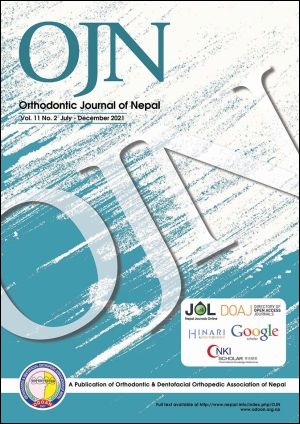Reproducibility and speed of cephalometric tracing between manual versus digital method
DOI:
https://doi.org/10.3126/ojn.v11i2.43275Keywords:
Cephalometric tracing, Digital method, Manual method, Reproducibility, Speed of tracing, Cephalometric tracing, Digital method, Manual method, Reproducibility, Speed of tracingAbstract
Introduction: Cephalometric tracing is an indispensable method for the evaluation of the growth and development of the facial skeleton. The clinical implication of the tracing may be utilized in many branches of dentistry for diagnosis and treatment planning. The research based cephalometric tracing has been widely used over a period of time by various specialist. The purpose of this study was to compare the cephalometric tracing method between manual and the digital method.
Materials and Method: Lateral cephalometric radiographs of 120 patients who came for orthodontic treatment during Jan 2020 to Dec 2020 were randomly selected from Tribhuvan University Dental Teaching Hospital and one orthodontic center. Only the cephalograms with clarity and without artefacts were selected. The samples were randomly selected without any discremation of gender, occlusal type or skeletal pattern. The two methods were compared in terms of reproducibility and the speed of cephalometric tracing. The cephalograms were compared using both the manual and the digital method using Vistadent OC 1.1 software program (GAC International Inc, Bohemia, New York, USA). The mean tracing time for each method was also estimated. Paired t –test was used to compare the differences in individual measurement between the two methods. Intraclass correlation coefficients were used to measure the repeatability of the measurements.
Results: On comparing two methods, 3 out of 20 measurements showed statistically significant difference while others showed no statistically significant difference. The mean time needed to perform cephalometric analysis by the digital method (4.61±0.63 minutes) was significantly less as compared to the manual method (11.23±0.71 minutes) and the difference of performance duration were statistically significant (<0.05). Intraclass correlation coefficient showed strong correlation (0.86 to 0.99) for each repeated cephalometric measurements carried out by both manual and digital methods.
Conclusion: Both conventional manual and digital cephalometry methods showed good reproducibility with strong correlation for repeated measurements. The digital method exhibited significant reduction in time compared to manual method. Incorporation of digital methods by the clinicians can increase their efficiency
Downloads
Downloads
Published
How to Cite
Issue
Section
License
Copyright (c) 2021 Orthodontic & Dentofacial Orthopedic Association of Nepal

This work is licensed under a Creative Commons Attribution 4.0 International License.
Copyright © held by Orthodontic & Dentofacial Orthopedic Association of Nepal
- Copyright on any research article is transferred in full to the Orthodontic & Dentofacial Orthopedic Association of Nepal upon publication in the journal. The copyright transfer includes the right to reproduce and distribute the article in any form of reproduction (printing, electronic media or any other form).
- Articles in the Orthodontic Journal of Nepal are Open Access articles published under the Creative Commons CC BY License (https://creativecommons.org/licenses/by/4.0/)
- This license permits use, distribution and reproduction in any medium, provided the original work is properly cited.




